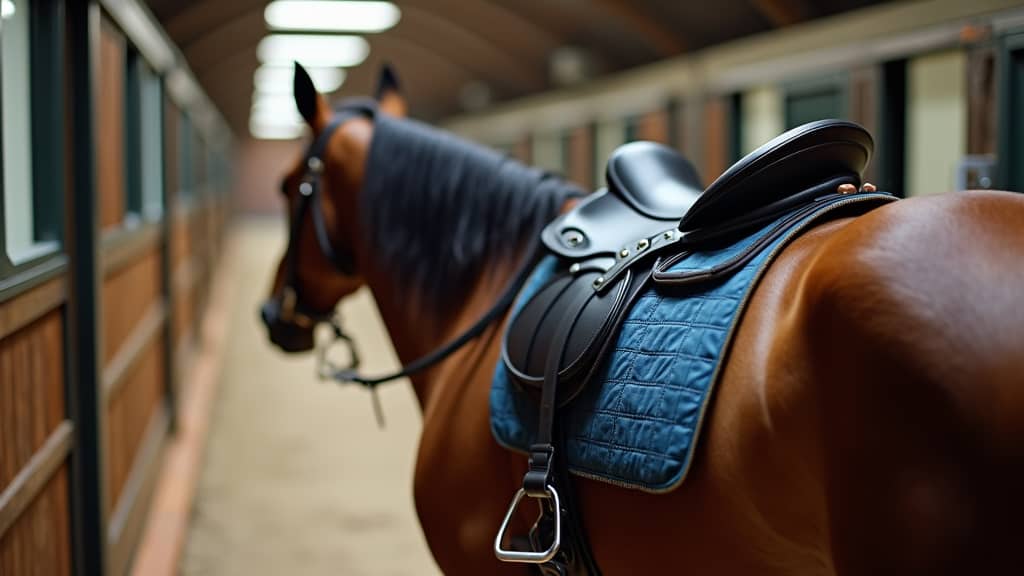
The Future Of Equine Technology
The Future Of Equine Technology – Opportunities And Challenges
Equine technology is transforming a field steeped in tradition. I have observed firsthand how modern innovations are reshaping the way riders, trainers, and stable managers interact with their horses. Today, advanced sensors, smart wearables, and data analytics create environments where horses can be monitored and cared for in real time. This progress offers both opportunities and challenges that every stakeholder should understand.
Innovations in Equine Technology and Their Impact
The integration of modern technology in equine management is changing how we bring out the best in our horses. I have seen devices that track vital signs, performance metrics, and even stress indicators during training sessions. Technologies such as these have the potential to optimize care and performance. They give trainers the chance to monitor the condition of their horses continuously, thereby preventing injury and improving training outcomes.
The field is evolving as more manufacturers commit to research and development. Various sensors and wearable devices are being developed to track movement, temperature, and heart rates. I have noticed that these devices can help in understanding each horse’s unique physical responses to stress and exercise. As more data is gathered, the potential for refining training methods grows, offering improved health outcomes and an overall boost in performance.
In addition to monitoring vital signs, advanced data analytics platforms are stepping up the game by processing vast amounts of information in real time. This extra layer of insight not only helps in making immediate adjustments during training sessions but also contributes to long-term improvements. Owners and managers can now compare performance trends over time, which makes it easier to spot emerging patterns that may indicate either progress or the need for adjustments in care routines.
Getting Started with Equine Technology
Before incorporating these new devices into a stable routine, I recommend understanding the fundamentals of each technology. Often, traditional methods coexist with modern digital tools. For example, hand-written records and observational skills remain very important. However, additional metrics provided by sensors can fill in gaps that conventional methods may miss.
When starting out, I find it helpful to review the intended purpose of each device. Some gadgets monitor physical activity, while others record environmental conditions. Knowing which technology fits your specific goals can simplify the process of integrating these innovations into everyday care routines. Researching the available options helps make informed decisions and eases the transition from old-school record keeping to data-driven management.
It is also beneficial to spend extra time comparing several products before making an investment. By reading user reviews and seeking advice from experienced colleagues, you can dig into the pros and cons of each gadget. This preliminary step ensures that the device you choose not only meets your current needs but also has the flexibility to adapt as your stable’s requirements change over time.
Steps to Embrace Horses’ Technological Future
Adopting equine technology requires a clear plan that aligns with your current practices. Here are several steps I follow to start embracing these tools:
- Assess Your Needs: Determine whether you need wearables to monitor performance or systems that keep track of health indicators. Align the technology with the most pressing needs of your stable. Taking the time to map out your exact requirements can prevent unnecessary expenditures later on.
- Review Available Devices: Look for equipment with features that suit your daily routines. Devices vary in function and price, so understanding what each offers is practical. It is essential to read through technical specifications and compare functionalities across different brands.
- Understand Data Usage: Learn how the data is collected and used. Reliable systems provide clear insights that help in decision-making during training or treatment sessions. In many cases, the software platforms that accompany these devices allow you to tap into the deeper layers of your data.
- Manage Costs: New technology can be expensive. It is wise to balance the adoption of advanced devices with the limitations of your budget. Starting with basic models may prove beneficial and then gradually upgrading as you gain experience. A phased approach ensures that you can assess the return on investment before committing to additional expenses.
- Train Your Team: Everyone who interacts with the technology should understand its features and limitations. This ensures that all personnel can operate the devices and interpret the data accurately. Regular, all-in-one training sessions can make a significant difference in the smooth adoption of new tools.
Following a structured approach can make the transition smoother, ensuring you benefit from technological advances without overwhelming your day-to-day processes. Taking the time to set up proper protocols and establishing regular review sessions will help make the most of these innovations over time.
Opportunities and Challenges in Equine Tech
The progress in equine technology creates exciting opportunities, though it also introduces challenges that require careful planning. I have experienced a mix of both that can serve as lessons for others looking to innovate in this space.
- Data Management: Advanced devices generate significant amounts of data. I have seen cases where data overload can complicate decision-making. Efficient data storage and analysis are central to tapping into technology effectively. When the volume of information becomes overwhelming, investing in robust software solutions can make all the difference.
- Integration with Traditional Practices: Modern tools do not replace conventional care methods. Instead, they supplement established management practices. The challenge lies in merging old and new. Combining historical expertise with the precision of digital monitoring helps create strategies that truly benefit the horse.
- Cost Implications: Upfront investment in equipment and training may be high. I believe careful budgeting and phased implementation help in managing these costs while still taking advantage of new technology. Weighing short-term expenditures against long-term gains is very important in a stable’s financial planning.
- Training and Adaptation: The learning curve associated with new devices can be steep. In my experience, gradual exposure and hands-on learning sessions have proven beneficial for staff and others involved in equine care. Consistent, all-in-one training sessions can ease this transition and foster an environment where technology is seen as a tool rather than an obstacle.
Every challenge presents an opportunity to refine processes and improve outcomes in horse care. With proper planning, the hurdles become manageable and pave the way for long-term benefits. I have also found that open discussions among team members, where experiences and best practices are shared, contribute significantly to overcoming technological obstacles.
Data Overload and Analysis
Modern devices may record countless data points. I have noticed that without appropriate data management systems, valuable insights may be lost in the volume of information. Investing in analytics software that organizes and interprets this data can turn raw numbers into actionable insights, enabling better management of training programs and health monitoring. Regular data review meetings help ensure that no critical information slips through the cracks.
Traditional Practices Meeting Modern Tools
Traditional techniques have provided reliable horse management for centuries. As I incorporate modern devices, the role of conventional skills becomes even more focused. Merging the best of both worlds can create well-rounded strategies that optimize training while upholding time-tested methods. I continue to value experienced judgment alongside digital guidance, making sure that every tool has its proper place in the stable.
The blend of historical practices with new-age technology also allows for the development of innovative protocols that respect tradition while embracing progress. It is essential to keep an eye on tried and true methods even as we explore the benefits of modern systems.
Cost versus Benefit Analysis
The expense of advanced equipment means that each investment should be carefully weighed against the potential benefits. In my practice, I consider both the short-term and long-term gains. The right technology not only has the capacity to improve performance but can also reduce long-term costs associated with injuries and inefficiencies. By comparing initial expenses with eventual savings in treatment and maintenance, a clearer picture of value emerges.
Training and Team Integration
The effectiveness of following technological advancements depends on the readiness of those who use them. All-in-one training sessions make a difference. I prioritize ongoing education to maintain proficiency in operating these devices, ensuring that all team members are capable of interpreting and acting on the data provided. Regular, hands-on workshops help build confidence and familiarity with the new systems.
When challenges are met with focused strategies, the transition in equine care can be smooth. I have come to understand that setting aside dedicated time for team training and routine data review sessions is highly beneficial. Sharing success stories and practical tips among colleagues further reinforces the adoption of technology.
Advanced Strategies and Applications
Once the basics are in place, I have explored advanced strategies to maximize the benefits of equine technology. These strategies expand on both the technical and practical applications available today.
Optimize Training Regimens: Modern sensors can measure variables like stride length and heart rate during training. I use this data to adjust the workload or intensity to match each horse’s condition. This practice can help prevent overtraining and reduce the risk of injury. Consistent adjustments based on real-time data allow for a more personalized training experience.
Monitor Veterinary Health Actively: Smart devices track indicators that often signal the need for veterinary attention. Relying on regular updates ensures that issues are spotted early. For instance, abnormal temperature readings can alert caretakers to potential infections before they become serious. This proactive approach minimizes downtime and contributes to overall health stability.
Give a Boost to Performance Analysis: Detailed performance tracking allows for better planning of race strategies or training sessions. For competitive scenarios, having accurate data on performance helps in designing specific routines that boost speed and stamina. By consistently reviewing performance metrics, trainers can fine-tune regimens and set realistic improvement targets.
Use of Mobile Applications: Many devices today integrate with mobile apps that offer easy-to-read dashboards. I find these interfaces useful for reviewing data on the go. Compact information on a smartphone can support decisions made in real time while out in the field or stable. This mobile connectivity ensures that no matter where you are, critical data is always within reach.
These advanced strategies are about gaining insights that help improve care and performance. Smart use of technology can step up how we train and care for horses. The data collected paves the way for more personalized training routines and better health management across the board.
Essential Tools and Core Technology in the Equine Field
Modern equine technology relies on a number of tools that work together to provide an all-in-one view of horse performance and health. I have seen that the right mix of devices can offer significant advantages across various aspects of horse management.
For instance, wearable collars and smart saddle pads can monitor everything from heart rate to movement efficiency. These devices come in handy not only for training but also for day-to-day care. Over time, the collected data can highlight trends that help in preventing injuries and optimizing nutrition plans.
- Wearable Sensors: Items like smart halters and collars track a horse’s vital signs continuously. They capture data related to overall health and can alert managers when readings fall outside typical ranges.
- Smart Saddle Pads: These items monitor movement and pressure. I have used them to adjust saddle fit, which helps in reducing discomfort during rides.
- Environmental Monitors: Devices installed in stables can track temperature and humidity. Maintaining stable conditions is very important for a horse’s well-being, and these monitors help in making necessary adjustments.
Using these tools in tandem provides a well-rounded approach to care. I have observed that when data from various devices is combined, it produces a robust profile of each horse’s daily experience, offering a clear picture that can drive better decision-making. This integrated system makes it easier to spot subtle changes that may indicate the need for intervention.
Frequently Asked Questions
I have compiled some common questions that I often encounter regarding equine technology. Readers might find these answers useful as they consider integrating these innovations into their routines.
Question: What initial steps should I take when introducing equine technology into my stable?
Answer: Start by researching the various devices available and aligning them with your specific needs. Consider beginning with basic sensors and wearables that monitor vital signs and movement. Pilot projects with a few devices can help assess practicality and benefits.
Question: How can equine technology help improve the daily care of horses?
Answer: Using technology to monitor health indicators provides reliable data that can guide routine care. Continuous monitoring can signal potential issues early, enabling more effective care and management. These benefits often outweigh the challenges associated with integrating new devices.
Question: Are there significant cost challenges when implementing equine technology?
Answer: While some devices can be expensive, starting with basic models allows for gradual investment. I have found that phased implementation based on immediate need and long-term benefit is a practical approach. Over time, the cost can be balanced with improvements in performance and health outcomes.
Question: What role does data play in managing equine health?
Answer: Data collected from various sensors can offer detailed insights into a horse’s physical condition. This information helps track progress, identify issues early, and tailor training programs to individual needs.
Conclusion
The future of equine technology holds many promising opportunities. I have observed that through the careful adoption of innovative tools, it becomes possible to step up the daily care and performance of horses. Integrated systems of wearables, sensors, and mobile applications offer clear benefits. They provide real-time data that supports informed decisions, ultimately contributing to the well-being and performance of each horse.
While the challenges of data management, cost, and training are real, they are manageable with careful planning and ongoing education. By combining traditional methods with modern technology, I believe we can create a well-rounded approach that benefits everyone involved. The gradual integration of technology not only refines training practices but also paves the way for smarter, data-driven decisions in horse care.
The transformation in the equine field is an adventure of opportunity and adaptation. Stakeholders who adopt these technologies are likely to experience improvements in performance, health monitoring, and overall efficiency. I encourage anyone interested in the well-being of horses to explore these innovative tools. The progress I have witnessed suggests that innovation in equine technology is here to stay, and with thoughtful integration, it can offer enduring benefits for years to come.
Looking forward, the equine industry is poised for a next-level cool glow-up as advancements continue to mix things up. Researchers, trainers, and technology experts are joining forces to bring together the best of both worlds. This collaborative spirit is driving a future where data, tradition, and innovation all play a part in nurturing the health and performance of horses. With continued investment in research and a commitment to training, the industry is set to enjoy a sustained period of improvement that benefits not only the animals but everyone involved in their care.



